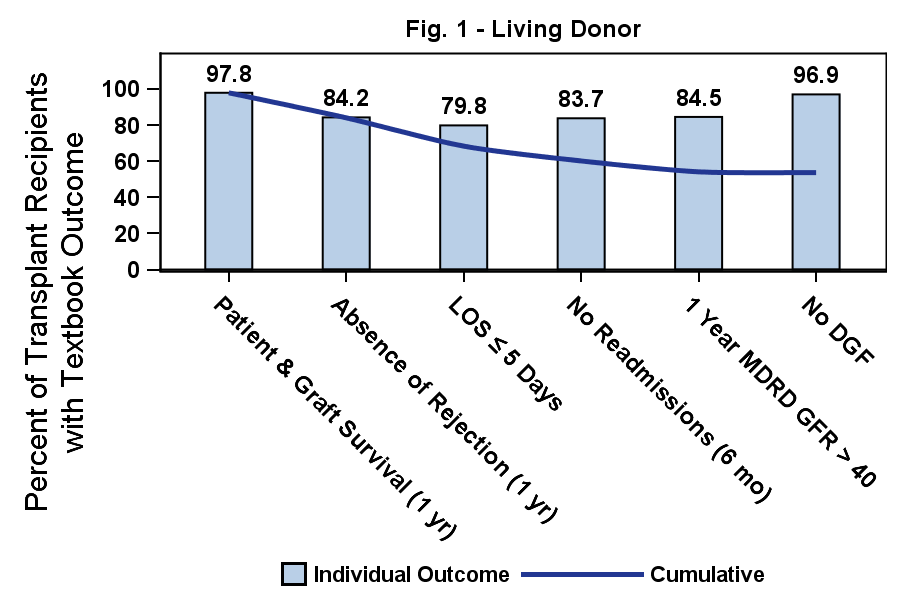Textbook Outcome as a Composite Quality Metric in Kidney Transplantation
Department of Surgery, Division of Transplantation, The Ohio State University Wexner Medical Center, Columbus, OH
Meeting: 2020 American Transplant Congress
Abstract number: 175
Keywords: Kidney transplantation, Length of stay, Outcome, Post-operative complications
Session Information
Session Name: Quality Assurance Process Improvement & Regulatory Issues I
Session Type: Oral Abstract Session
Date: Saturday, May 30, 2020
Session Time: 3:15pm-4:45pm
 Presentation Time: 3:51pm-4:03pm
Presentation Time: 3:51pm-4:03pm
Location: Virtual
*Purpose: Textbook outcomes (TO) describe ideal patient outcomes following specific surgical procedures and are useful composite quality metrics for patients, providers and payors. We aimed to define TO following kidney transplantation (KT) and identify donor and recipient characteristics predictive of TO following both living (LDKT) and deceased donor transplantation (DDKT).
*Methods: National UNOS STAR files for 23,809 LDKT and 52,451 DDKT recipients transplanted between 2013 and 2017 were used to define TO as patient and graft survival > 1 year, length of stay ≤ 5 days, 0 readmissions within 6 months, absence of rejection, MDRD GFR > 40 at 1 year, and absence of delayed graft function. Univariate analysis identified donor and recipient characteristics associated with TO. Covariates were analyzed using purposeful selection to construct a multivariate model.
*Results: The national average TO rate was 53.6% for LDKT (Figure 1, 95% CI 53.0% – 54.3%) and 31.5% for DDKT (Figure 2, 95% CI 31.1% – 31.9%). LDKT recipients most likely to have a TO were young (OR .983, 95% CI 0.981 – 0.985), low PRA (OR .997, 95% CI 0.996 – 0.998), non-diabetic (OR 1.17, 95% CI 1.10 – 1.24) patients who were not on pre-transplant dialysis (OR 1.2, 95% CI 1.15 – 1.28) and had pre-transplant Karnofsky scores between 80-100% (OR 2.4, 95% CI 1.9 – 3.0). DDKT recipients most likely to have a TO were not on pre-transplant dialysis (OR 1.46, 95% CI 1.37 – 1.55), had pre-transplant Karnofsky scores between 80-100% (OR 1.8, 95% CI 1.6 – 2.1), and received low KDPI (OR 0.36, 95% CI 0.33 – 0.41), non-DCD (OR 1.74, 95% CI 1.65 – 1.83) allografts with shorter cold ischemic times (OR 0.987, 95% CI 0.985 – 0.990).
*Conclusions: TO is a composite patient-centric quality metric that incorporates outcome measures related to graft function and resource utilization. TO was achieved in 53.6% of LDKT recipients and 31.5% of DDKT recipients. Recipient health was the most notable determinant of TO in LDKT recipients while donor quality affected TO rates in DDKT recipients. TO may be an important measure of transplant center quality in addition to the current standard of 1-year patient and graft outcomes.
To cite this abstract in AMA style:
Han JL, Logan AJ, Sneddon JM, Brock GL, Washburn KW, Schenk AD. Textbook Outcome as a Composite Quality Metric in Kidney Transplantation [abstract]. Am J Transplant. 2020; 20 (suppl 3). https://atcmeetingabstracts.com/abstract/textbook-outcome-as-a-composite-quality-metric-in-kidney-transplantation/. Accessed December 17, 2025.« Back to 2020 American Transplant Congress


